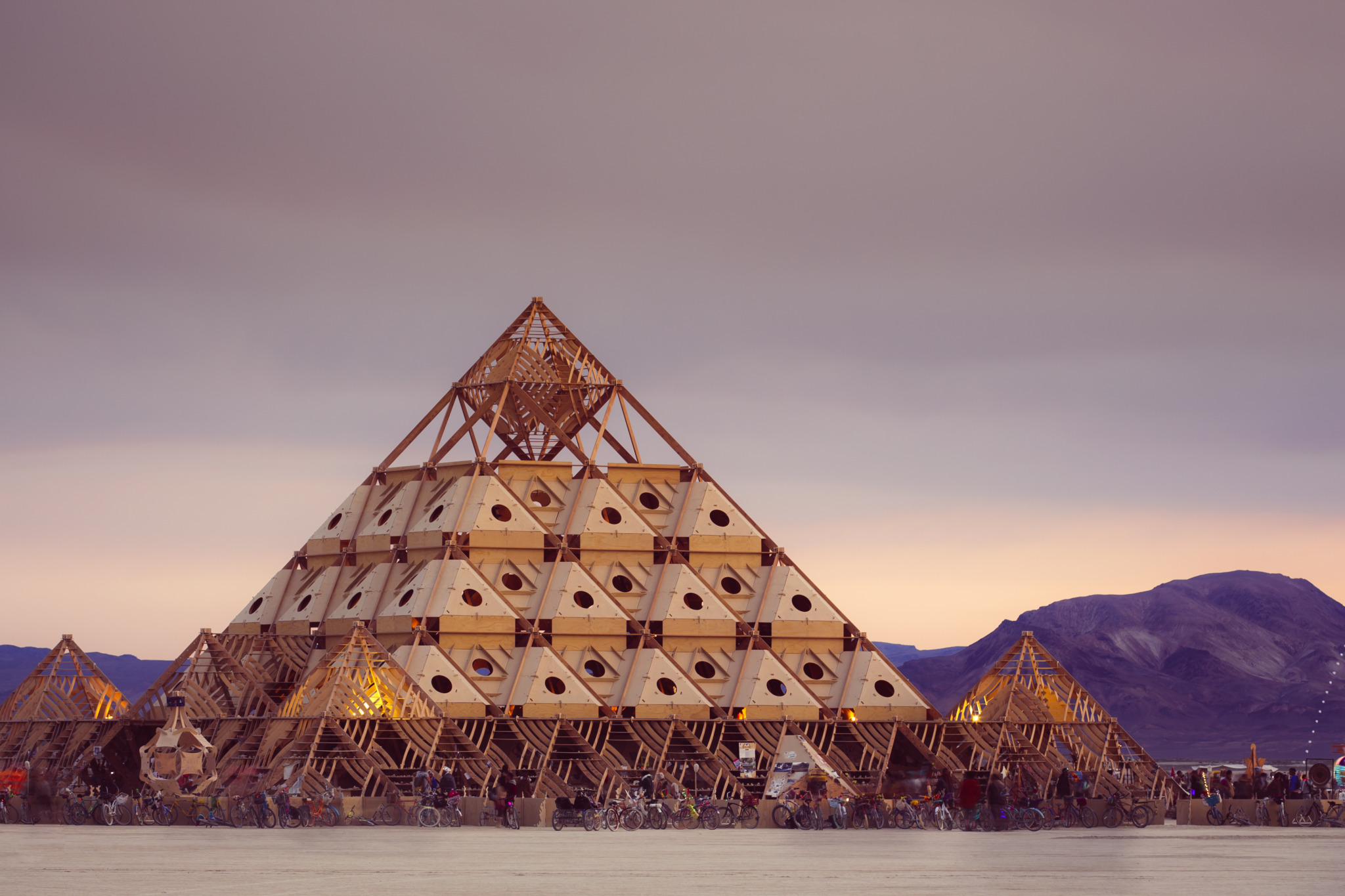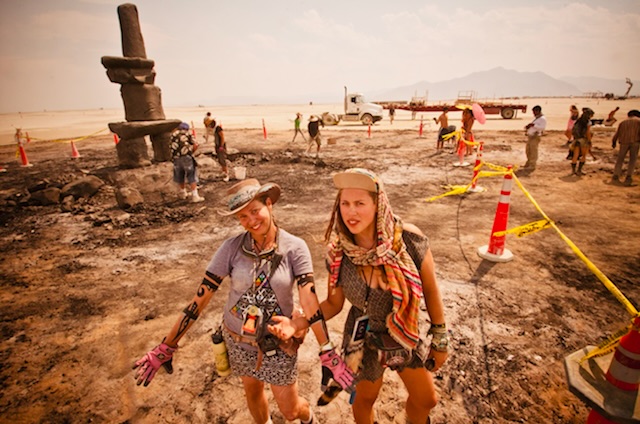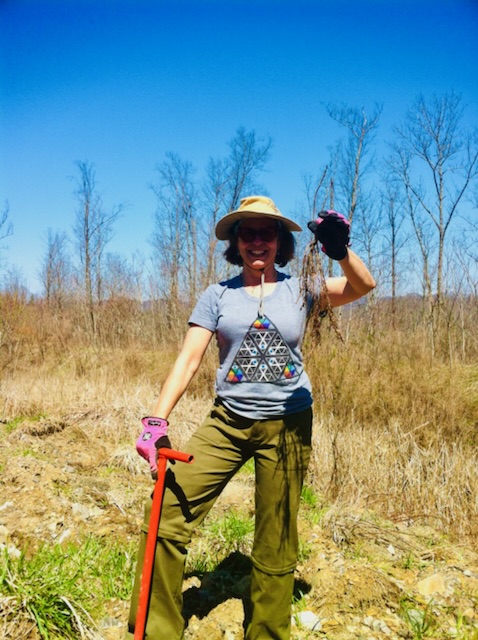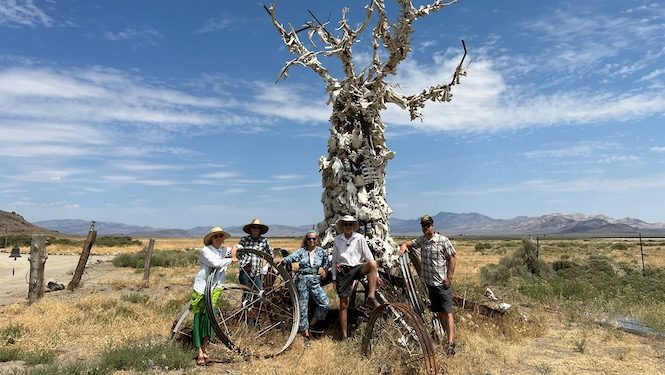You can’t create giant wooden art without sacrificing a few trees. This is a fact that’s never been lost on Syn, aka Melissa Barron, an artist and activist who has been firmly planted in the inner sanctum of the Burning Man community—her partner, Lightning Clearwater III, is a board member of Burning Man Project and was Burning Man’s General Counsel for many years.
After bringing several wood-heavy art projects to playa including 2011’s “Otic Oasis,” Syn and Lightning, along with fellow artist Gregg Fleishman, were selected to bring their talents to the Temple. In 2013, they built “The Temple of Whollyness,” a pyramid-shaped structure made entirely of interlocking wood pieces with no nails, glue, or metal fasteners. The intentions of the crew were noble, to create big art with as little environmental impact as possible. Though they were on track to accomplish that feat on several levels, during the build Syn recognized a glaring omission.

Here, Syn shares the origin story of Art for Trees, the organization she founded to offset the construction lumber used in art projects and the carbon emissions from their burns.
Thanks so much for chatting with me! How did you come up with the idea for Art for Trees?
Syn: When we were building the “Temple [of Whollyness]” we had to use new hardwood plywood and softwood structural lumber because of the precision building necessary to have all the pieces fit together without metal fasteners. We couldn’t have even a slight variance or warping of the structural struts, which made it impossible for us to use recycled lumber or plywood. One day during the build I was belt sanding out the lumber stamps on the struts that contained the name of the lumber company—we’re old school and were that pure and take Decommodification seriously so didn’t want any corporate names to be visible—and I saw the manufacture date, which was just the month before. Suddenly I couldn’t stop crying because I knew we were going to be burning all of this wood that had been trees until very recently.

I have been considered a tree hugger since high school. I walked in the first Earth Day demonstration on April 22, 1970. I wanted to be a forest ranger. My undergrad degree is environmental planning and management and landscape architecture from UC Davis. So, I started questioning, how many trees are we burning here? I was having a crisis of faith.
I contacted a forester to calculate how many trees had been felled to manufacture this lumber and plywood, and the number of trees we would need to replant to offset what we were using for the Temple. I learned that a tree must grow to at least 40 years of age before being harvested to be used as structural lumber. I learned that a board comes from the main trunk of the tree and the branches are rarely used. We calculated that slightly less than 1,000 trees had been necessary to create the wood used in the Temple.
So in early August 2013, on the way out to the playa to start the Temple build, I decided to start a crowdfunding campaign to raise funds to plant 2,000 trees, twice the number of trees used in the Temple, to factor in the survivability of the planted trees.
To me, Leaving No Trace means more than feathers and glitter detritus left on the playa, it means looking at your global trace; it also means leaving a positive trace. So, I quietly raised these funds to plant 2,000 trees. I then partnered with a nonprofit in Appalachia to plant hardwood trees to replenish the plywood we used. I even traveled to Tennessee and spent a week tree planting, and funded the planting of Douglas fir in California to replenish the structural lumber used in the Temple.
That’s incredible! How has Art for Trees grown since then?
Every burn year since 2013, I continued to replenish wood not only from our installations, but to plant trees to replenish wood used at the other major art installations on playa, including the Temple, and to offset the carbon emissions from the multiple burns at the end of the event. I reasoned that if I worked on raising funds to plant trees and raised consciousness about our need to conserve, it would send a message to our community that positive reciprocal actions towards nature better reflect our core values and overall sustainability.

Maybe it’s a generational thing; I’m a Boomer. I believe that it’s more important to do the thing than to get recognition for it. There were times when I thought nobody cares about this, but I reminded myself that there are a number of private donors concerned about the environment and interested in supporting this issue, and that’s how it’s progressed. Every year we have raised funds and planted trees to offset wood burned on the playa.
I am just one person doing a small thing and I just keep doing it every year, adding to the many other individuals who keep working for this type of ideal. It’s about consistency. The first five years of a seedling’s growth is all about root growth, so you won’t see much height in newly-planted trees for the first 10 years, but then the trees grow and grow. The trees we planted in the spring cycle of 2014 in Appalachia are between six and 10 feet tall now, and that’s in less than nine years. Since the start of Art for Trees we’ve planted more than 110,000 trees.

What’s next for Art for Trees?
In the fall of 2019, I approached Fly Ranch about creating the Fly Ranch Grove Project, an homage to Larry Harvey, incorporating iconic Burning Man art installations that were based on Trees—like the “Bone Tree” by Dana Albany, which Larry loved—and also planting indigenous trees that can grow in the area, such as cottonwoods, acacias, and black locust trees. We were slowed down by COVID-19, but it’s a long-term, living, and evolving art installation.
My goal this year is teaming up with Folly Builders and their 2022 Burning Man project “Paradisium”—a dynamic, artistic forest ecosystem—using the funds we raise together to plant between 30,000 and 50,000 trees. “Paradisium” aims to be as sustainable as possible when building, to rehome the project’s trees instead of burning them, and to plant as many trees as possible. I’m hoping to be their tree planting engine, so they can focus on building and rehoming. My hope is to rehome some of the “Paradisium” trees at the Fly Ranch Grove.
Overall, it would be great if planting trees became a natural reciprocity, something I call Radical Reciprocity, where caring for the environment becomes as natural as caring for your children. The most elegant and simplest way to help [alleviate] climate change is to keep planting trees. When you plant one tree it has a huge ripple effect influencing soil remediation, water runoff, the quality of the water, the fish and the birds, and more. It creates more positive benefits than just planted trees.
Let’s keep planting trees together! 🌳🌳🌳
Support and Follow Art for Trees!
- Support Art for Trees’s 2022 Fundraiser
- Follow Art for Trees on Facebook
- Follow Art for Trees on Instagram
Cover image: Lisa (Scirpus) Beers, James (Flag) Lanham, Melissa (Syn) Barron, Tom Stille and Iris Stille in front of “Bone Tree” by Dana Albany, 1999 (Photo courtesy of Syn)

